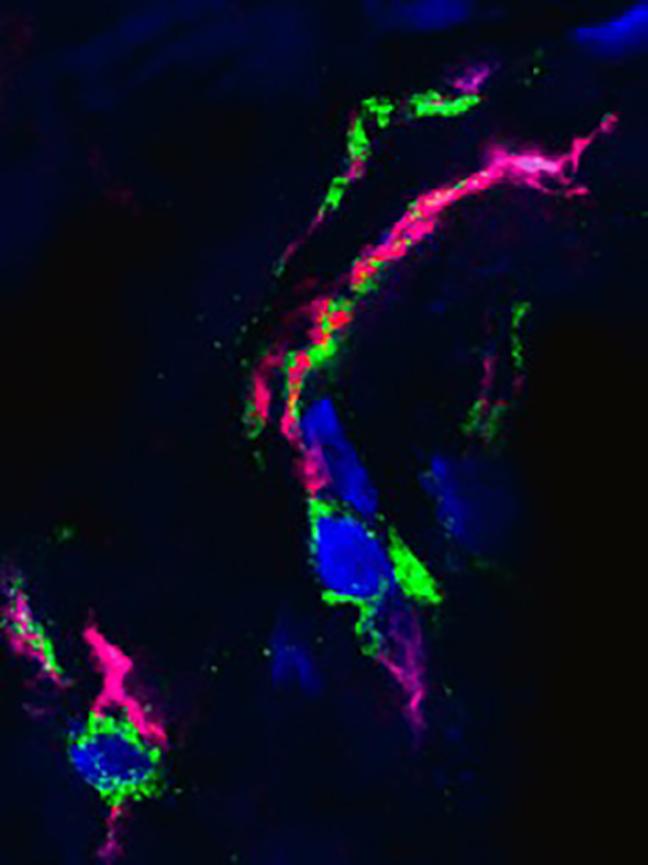
Credit: © 2020 Radermecker et al. Originally published in Journal of Experimental Medicine. https://doi.org/10.1084/jem.20201012
Sticky webs of DNA released from immune cells known as neutrophils may cause much of the tissue damage associated with severe COVID-19 infections, according to two new studies published September 14 in the Journal of Experimental Medicine (JEM). The research, conducted by independent groups in Belgium and Brazil, suggests that blocking the release of these DNA webs could be a new therapeutic target for the management of severe forms of COVID-19.
While many people infected with the SARS-CoV-2 virus experience relatively mild symptoms, some patients mount an excessive inflammatory response that can damage the lungs and cause acute respiratory distress syndrome (ARDS), leading to low blood oxygen levels and, potentially, patient death. An early indicator of severe COVID-19 is an increased number of circulating neutrophils, a type of white blood cell. Neutrophils can catch and kill invading microbes by unwinding their DNA and extruding it from the cell to form sticky webs known as neutrophil extracellular traps (NETs). NETs can also damage surrounding tissue, however, and could therefore cause some of the lung pathology associated with severe COVID-19.
In one of the new studies, a research team from Liege University’s GIGA Institute led by Thomas Marichal, Cécile Oury, and Philippe Delvenne examined the lungs of patients who had succumbed to COVID-19 and found large numbers of NETs dispersed throughout the organ. The researchers saw many NETs in the airway compartment, where they often appeared to almost completely obstruct the small bronchioles and alveoli that mediate gas exchange. NETs were also formed at sites of inflammation located in the interstitial compartment between the alveoli and blood vessels, and could even be seen in the blood vessels themselves near tiny blood clots known as micro-thrombi that can restrict blood flow through the lungs and are a common pathological feature of severe COVID-19 patients.
“NETs can form a platform for the adhesion of platelets and other blood-clotting factors, but whether NETs actually contribute to the formation of COVID-19-associated pulmonary micro-thrombi will require further investigation,” says Thomas Marichal. “Altogether, our study supports the idea that targeting NETs in COVID-19 patients may help the clinical management of severe forms of COVID-19 by alleviating thrombotic events, excessive tissue-damaging inflammation, fibrosis, and airway obstruction.”
In the second study, a team of researchers led by Fernando Queiroz Cunha, Flavio Protasio Veras, and Thiago Mattar Cunha at the University of São Paulo also identified increased numbers of NETs in the lungs of severe COVID-19 patients and found that NET formation was elevated in COVID-19 patients’ blood plasma as well. Moreover, the researchers determined that SARS-CoV-2 can trigger the release of NETs by infecting neutrophils and replicating inside of them. NETs released from SARS-CoV-2-infected neutrophils induce the death of lung cells grown in the lab, the researchers found, but cell death is prevented if NET release is inhibited or the NETs are degraded by an enzyme that chews up DNA.
“Our study supports the use of inhibitors of NET synthesis or promoters of NET fragmentation as a strategy to ameliorate the organ damage associated with severe COVID-19,” says Fernando Queiroz Cunha.
###
Radermecker et al., 2020. J. Exp. Med. https:/
Veras et al., 2020. J. Exp. Med. https:/
About the Journal of Experimental Medicine
The Journal of Experimental Medicine (JEM) features peer-reviewed research on immunology, cancer biology, stem cell biology, microbial pathogenesis, vascular biology, and neurobiology. All editorial decisions are made by research-active scientists in conjunction with in-house scientific editors. JEM makes all of its content free online no later than six months after publication. Established in 1896, JEM is published by Rockefeller University Press. For more information, visit https:/
Visit our https:/
Follow JEM on Twitter at https:/
Media Contact
Ben Short
[email protected]




